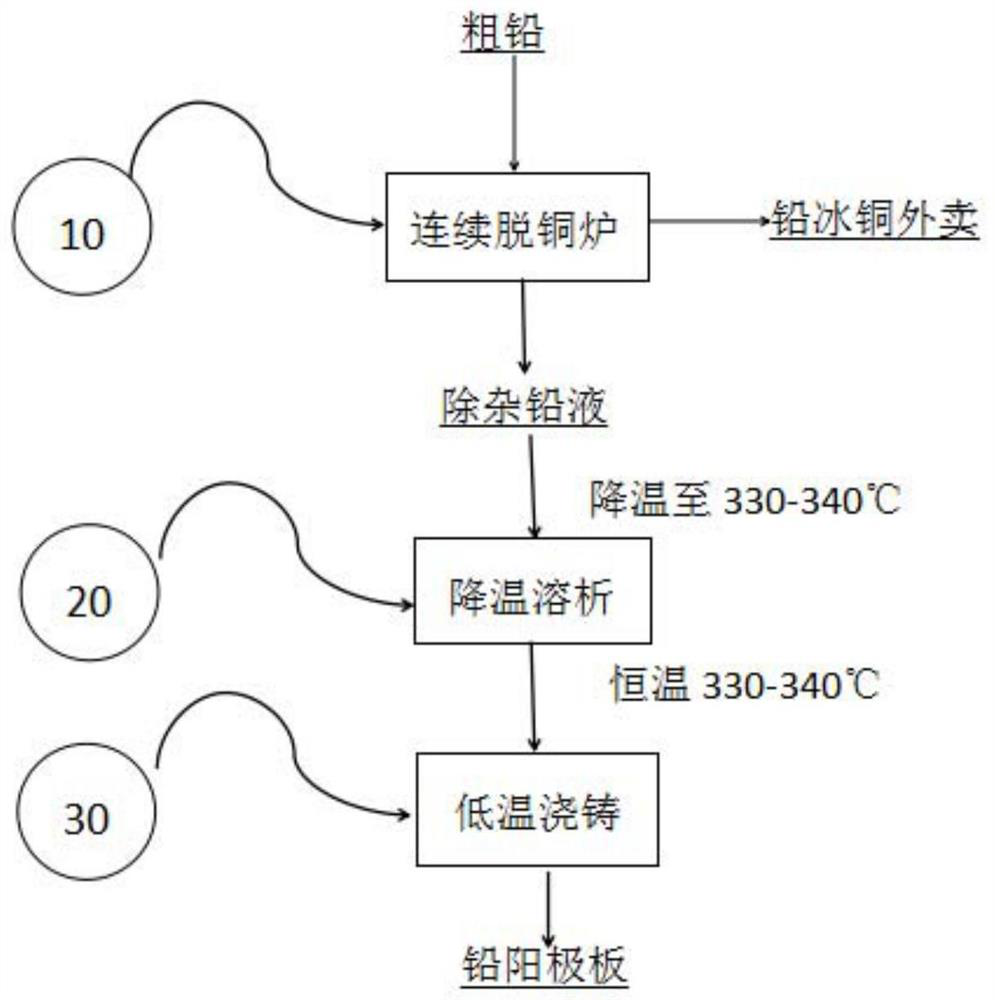A low-temperature casting process of lead anode plate
A low-temperature technology for lead anodes and plates, applied in the field of lead pyrometallurgy, can solve the problems of incomplete copper removal, affect economic benefits, affect the current efficiency of lead electrolysis, etc., and achieve the effects of avoiding lead foam, improving purity, and eliminating lead foam.
- Summary
- Abstract
- Description
- Claims
- Application Information
AI Technical Summary
Problems solved by technology
Method used
Image
Examples
Embodiment 1
[0037] The crude lead liquid is added to the continuous decopper furnace, and sulfur is added according to the copper content of the lead liquid to obtain lead matte and impurity-removing lead liquid. Carry out elution and decopper at 330°C, and the obtained copper-removing lead solution contains 0.065wt% copper, then keep the temperature at 330°C, and perform casting to obtain a lead anode plate containing less than 0.04wt% copper, and no lead foam is generated during the casting process.
Embodiment 2
[0039] Add crude lead liquid to the continuous decopper furnace, add sulfur according to the calculation of copper content in lead liquid, obtain lead matte and lead liquid for removing impurities, lead liquid for removing impurities contains less than 1wt% copper, then cool the lead liquid for removing impurities to Carry out elution and decopper at 335°C, and the obtained copper-removing lead solution contains 0.067wt% copper, and then keep the temperature at 335°C, and perform casting to obtain a lead anode plate containing less than 0.04wt% copper, and no lead foam is generated during the casting process.
Embodiment 3
[0041] Add crude lead liquid to the continuous decopper furnace, add sulfur according to the calculation of copper content in lead liquid, obtain lead matte and lead liquid for removing impurities, lead liquid for removing impurities contains less than 1wt% copper, then cool the lead liquid for removing impurities to Carry out elution and decopper at 340°C, the obtained copper-free lead solution contains 0.07wt% copper, then keep the temperature at 340°C, and perform casting to obtain a lead anode plate containing less than 0.05wt% copper, and no lead foam is produced during the casting process.
PUM
 Login to View More
Login to View More Abstract
Description
Claims
Application Information
 Login to View More
Login to View More - R&D
- Intellectual Property
- Life Sciences
- Materials
- Tech Scout
- Unparalleled Data Quality
- Higher Quality Content
- 60% Fewer Hallucinations
Browse by: Latest US Patents, China's latest patents, Technical Efficacy Thesaurus, Application Domain, Technology Topic, Popular Technical Reports.
© 2025 PatSnap. All rights reserved.Legal|Privacy policy|Modern Slavery Act Transparency Statement|Sitemap|About US| Contact US: help@patsnap.com

